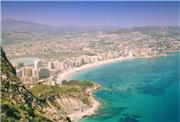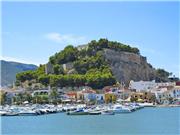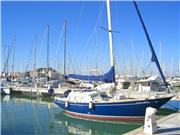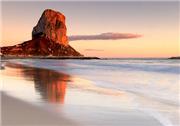-
Properties Costa Blanca
-
 Costa Blanca (white coast) is the name of the Spanish province Alicante between the Cabo de la Nao and the Cabo de Palos in the east of Cartagena, province of Murcia.
Costa Blanca (white coast) is the name of the Spanish province Alicante between the Cabo de la Nao and the Cabo de Palos in the east of Cartagena, province of Murcia.
The coast has its name in one part because of the traditional white painted houses and on the other because of the bright sunlight that turns the sandy beaches into white color. The opposite between the blue sea and the white colored coast is also represented in the blue and white flag of Alicante (“town of light”), which is part of the Costa Blanca. In the south the Costa Calida joins to the Costa Blanca and it depends on the situation of the river source of the Mar Menor it belongs to one part of the coast or the other. -
 With the revaluation of the pound and the airplane connections to England the coast has won a lot of interest in English people, who love to visit the crowded Benidorm.
With the revaluation of the pound and the airplane connections to England the coast has won a lot of interest in English people, who love to visit the crowded Benidorm. -
The mild climate turns the Costa Blanca in such a popular holiday location for tourists from all parts of Spain and whole Europe. In the 50’s the first Germans started to settle down in this area. Some of the Germans with a Nazi past found the ideal place to hide, as Franco offered them an inconspicuous life and protection against international criminal prosecution. After Franco’s death and with the democracy the region noticed an economic recovery with the tourism, which continues the same nowadays, except for a small amount on burglaries.
-
The Costa Blanca is now the motor of the Spanish economy. With the tourism the construction volume started to grow and turned the region into one of the biggest construction areas in Europe. The region counts with 13 golf courses neighboring to large urbanizations with up to 20,000 living units. Another 52 golf courses are already planned. In the past years building licenses were issued on more than 70,000 projects, and it seems to find no end. Now it turns up to be more and more difficult to find clients who accept to pay those high prices for a real estate. You can notice that financially strong people from east Europe start to settle down on the Costa Blanca. As a proof is the Russian Orthodox Church underneath the luxury urbanization Altea Hills.
-
The most popular tourist destinations are theme parks as Terra Mitica, Mundomar, Terra Natura and Aqualandia. In Valencia you can find the “Cuidad de las Artes y Ciencias”, the city of the arts and sciences, a futuristic project with a science museum, planetarium and water park and aquarium. You can enjoy visits to the theatre, concerts and operas in the adjoining art palace.
-
 If you are nearby Denia, your gaze will fall first on the imposing castle, which rises on a hill above Denia and stores the witness about the eventful history of Denia. The night lighting of the castle is very beautiful and in the numerous museums and exhibitions you will find interesting information about the eventful history of the city, which have called the Romans “Dianium” and the Moors “Daniya”. Even today, numerous architectural traces of the Romans and Moors to discover spectacularly represented at the festivities “Moros y Cristianos”, which reminds every year in August to the reconquest of the territories occupied by the Moors the city by the Christians. In and through all the other cultural and historical attractions happy to inform you, the tourist office.
If you are nearby Denia, your gaze will fall first on the imposing castle, which rises on a hill above Denia and stores the witness about the eventful history of Denia. The night lighting of the castle is very beautiful and in the numerous museums and exhibitions you will find interesting information about the eventful history of the city, which have called the Romans “Dianium” and the Moors “Daniya”. Even today, numerous architectural traces of the Romans and Moors to discover spectacularly represented at the festivities “Moros y Cristianos”, which reminds every year in August to the reconquest of the territories occupied by the Moors the city by the Christians. In and through all the other cultural and historical attractions happy to inform you, the tourist office. -
In Valencia, there is the “Ciutat de les Arts Ciències y”, the City of Arts and Sciences, a futuristic project with a science museum, a planetarium and water park. In the adjoining Palace of Art plays, concerts and operas are performed.
-

Altea Alicante HarbourCertainly worth seeing are also the small villages in the hinterland. Many of the villages have not yet received their Spanish origin, other villages that are closer to the coast, are not spared of vacation resorts and luxury apartments. Nevertheless, especially the villages of Jalon, Lliber, Alcalali, Parcent, Murla, Castell de Castels, Guadalest, and many others are worth visiting.
-
If you require some further information over the inland locations or daily trips on the white coast you can always visit the tourist info that can easily be found in bigger towns. Between the Jalon mountains, in Les Murtes, lies a donkey farm with German owners, who look for rescue and recovery from the endangered Andalusia giant donkeys.
-

As there are not so many accommodation possibilities you are bound to the big hotels on the coast, which are totally booked out months before. With a bit of luck you can find an accommodation between Jalon and Benissa.
Der Peñón de Ifach
-
Jalon is famous for its wine, raisins and almond products, as well as for its kind of sausages “embutidos”. A car boot sale takes place every Saturday morning, where mostly elder clients can purchase all type of stuff. A tale says that somebody from Madrid once purchased a very expensive picture for little money here, so the car boot sale keeps growing more and more.
-
In the lovely location Lliber you can find an international, English guided, school. As the teaching is mostly in English a lot of German, Russian, Spanish and Dutch people take their children to this school.
An idyllic trip destination is the ruin Preventori d’Aigües from a previous luxury recovery hotel and later tuberculoses sanatorium near Alicante.

